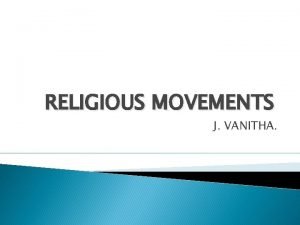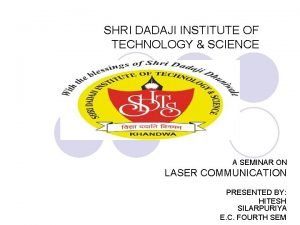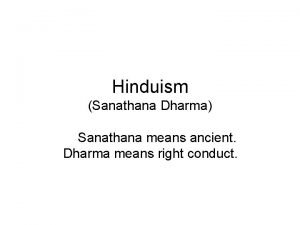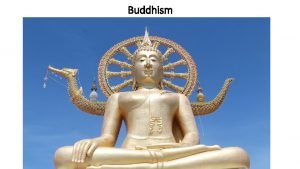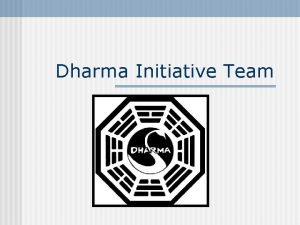Shri Narayana Dharma Paripalanam SNDP Movement Shri Narayana










- Slides: 10

Shri Narayana Dharma Paripalanam SNDP Movement

Shri Narayana Dharma Paripalana (SNDP) Movement • The untouchable Ezhavas or Iravas of Kerala clustered around the religious leader Shri Narayana Guru (1855 -1928), who formed the Sri Narayana Dharma Paripalana Yogam (SNDPY) in 1902 -3. It organized some temple entry rights movements.

Shri Narayana Guru

Historical Background • This movement was based on the approach of reinterpreting Hindu religion in search of selfdetermination. The Sri Narayana Dharam Paripalana Movement was the movement for the propagation of Sri Narayana Guru Swamy's philosophy among the Izhavas (toddy tappars) of Kerala. • Until 1935 the Izhavas belonged to the Scheduled Caste category. They were considered to be unapproachable by the other castes.

Cont… • Izhavas that formed about 26% of the Kerala's total population suffered from many religious, political and economic disabilities. • Around the turn of the century a charismatic leader Sri Narayan Guru Swamy gave them a new religion of one God and one caste which transformed their life styles and outlook. • He established a set of religious institutions parallel to that of the variety of Brahmanical Hinduism. • This helped Izhavas both to gain self-respect and to adopt a protest ideology to challenge the religious, economic, educational and political supremacy the upper castes.

Causes for the Movement • This movement was lunched among the Izhavas of Keral by their leader Narayan Guru. • Traditionally, Izhavas were an untouchable castes of Toddy Trappers e. g. they had to stay away thirty four feet from the Namboodhari Brahmins. • They suffered from many other disabilities both social and ritual. • They were denied access to Hindu temples or to the bathing tank of Hindus. • Their women were not allowed to cover their breast or to wear any footwear, nor could they build good house.

Cont… • In the later part of the 19 th century with the spread of modern humanistic and secular ideas and also the spread of egalitarian -ideas through Christianity, Izhavas came to view their situation as one of the deprivation and exploitation. • Under the charismatic leadership of Sri Narayan Guru they rejected Brahminical domination and development a new interpretation of Hinduism. • Next according to MSA Rao, they adopted the strategy of withdrawal and self organisation.

Idealogy • The new idealogy was based on the principle of self-respect, honour and worth of individual. • It was an ideology of protest against the Brahminical values system of hierarchy and pollution. • S. N. Guru established a parallel source of legitimacy by establishing new institutions like temple priest, monk and monasteries.

Achievements • Later T. V. Madhavan led the Vaikum Temple Road Entry Movement in 1927, under the patronage of Mahatma Gandhi. • After the two years of sustained Satyagraha the Izhavas were granted the right to use the road which ran near the Vaikum Temple which was woned by upper caste. • This was a historic victory against orthodox ideas of pollution. • Thus, the leaders of the movement were able to achieve for their followers all the basic rights in the field of religion, education, employment and politics.

Cont… • The SNDP movement represented one of the most successful attempts of the untouchable castes to alter the traditional balance of power besides improving their own positions. • It also demonstrated that it was possible to remain within the fold of Hinduism and yet escape from the stigma of untouchability. • The new awareness arose among Izhavas tribes. • The movement motivated them to take to modern education which in the long run enabled them to aces to the modern occupation and professions which carried high rewards in terms of prestige and wealth. • Thus Izhavas as a community successfully raised their status in society by the contribution of SNDP movement.

